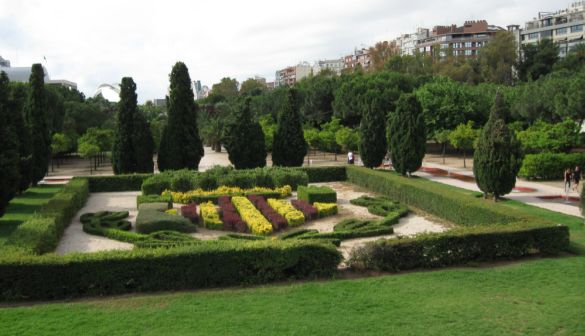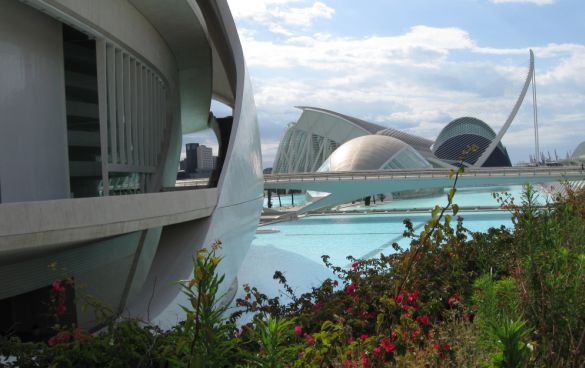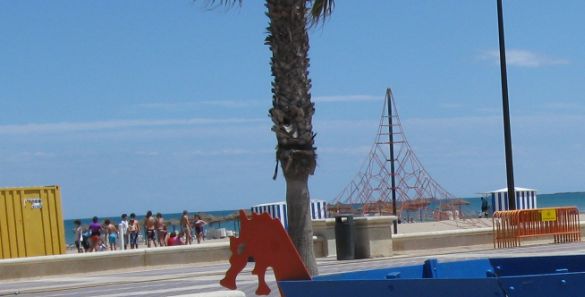Valencia, Spain’s third largest city, takes me by surprise – with an accommodation far better than paid for. It’s not a singular experience, for things often turn out better, bolder and more beautiful here than elsewhere, as if some supernatural force was at work.
The history of Valencia does contain the usual list of conquering forces up through the centuries, but one power was different and kept coming back – that was the power of water. The floods of the river Turia repeatedly threatened to reduce Valencia to point zero, the last attempt was in 1957, after which Turia was eventually redirected outside and away from the city.
An empty riverbed is normally no pretty sight. Filling it with asphalt and cars would be an obvious solution, whereas unnecessary bridges could be pulled down, in some cases perhaps reused in the new location. There was a fight about this in 1966, citizens against authorities and politicians. The Valencians seemed determined to get something back from the cruel river – more than just traffic – even if they had to put more money in it. They apparently considered the riverbed a resource that might enhance the qualities of Valencia in the future.
There were several clues to guide them – a growing consciousness about the environment, a developing democracy demanding sustainable solutions, there were contemporary talents within art and architecture waiting to be challenged. Valencia wanted to be at the forefront. The answer was Turia Gardens, a seven kilometer long park meandering toward the sea just like the old river did. When caressing the eastern side of the Old Town, the park forms a synthesis between a historical past and a future they wish to have an influence on.
River-bed walk
The traditional sights are located in the Old Town, most visible from the riverbed are the towers of Torres de Serranos, a Gothic city gateway. Main impressions though, are made by trees, flowers, fountains, sport facilities, paths for walkers, joggers and bikes, ponds for dogs to bathe in. No cars – they are still carried across via the old bridges, as cars always were. Every age and style participate in this bridge parade. The combination of old and new comes naturally in Valencia.
Turia Gardens tie everything together – starting at the upper end with Bioparc, a new generation zoo where visitors are allowed to enter the recreated habitats of 250 species of wild animals, the first phase covering Africa, Southeast Asia will be next. School classes queue to get in, perhaps inspired by all that nature outside their doors, a guarantee that future generations will preserve and develop the Gardens. Two architectural pearls have been admitted into the park to accentuate it – the Palace of Music and a Congress Palace.
The lower end of the park is an architectural explosion, created by Santiago Calatrava and Felix Candela, world famous architects, the former a Valencian himself, who has dotted the world map with spectacular buildings. Here in his hometown is a wide collection, varied yet in harmony. With a touch of irony, they emerge from pools of water – as individual structures, the accumulation of which makes up a city of its own – City of Arts and Sciences, CAC.
Prestigious project
The CAC is a monument not only to the architects and their profession, but also to the citizens who persuaded their own leaders to support a project that had no precedent. Valencia is traditionally regarded as a conservative stronghold. A possible skepticism toward this project soon turned to enthusiasm. Its successful completion did boost the prestige of Valencia, the city as well as the autonomous region whose capital it is. Today, many a visitor stores Valencia as “Science City” in their memory.
However, there are the arts too, in the Palace of the Arts Reina Sofia, built for music and drama performances, mostly referred to as the Opera. The building is indescribable, the view of it changes all the time, depending on your perspective. You may come to think of a ship or the crushed shell of an egg, and wonder what Queen Sofia thinks of her building, which she has surely visited on several occasions since the opening in 2005. She has definitely her own opinion whether this construction deserves a place among the more mythical opera houses of the world.
There to keep an eye on you – since 1998 – is the Hemisferic, an enormous eye resting in a pool, opening and closing. It’s the eye of knowledge, a knowledge presented by means of a large scale IMAX cinema and digital projections in the case of astronomy and entertainment. If all you want is a walk, the Umbracle is prepared to make it tree-lined and surround you with plants indigenous to this part of Spain, while you enjoy the arches of the building and views of Science City, also its high-rise neighbors at a respectable distance.
The skeleton of a whale does not scare children or parents away, many of them not aware that this is what Mr. Calatrava had in mind when designing the Prince Felipe Museum of Science. It’s a science center where you learn by touching and experiencing. The contents of it appear rather traditional. The Oceanografic, however, is bursting with life, most of it below sea surface – walruses, beluga whales, sea lions and penguins. You may not wish to touch the sharks, here you can sleep with them instead.
Crazy Valencians
Popular sights are ranked in a Top 10 list. Turia Gardens do not fit in, whereas City of Arts and Sciences does – as number eight. Brave new architecture alone does not make a winner, especially when combined with high entrance fees. But if the building style contains layers of history and an abundance of elegant details, you keep coming back, and Valencia’s compact Old Town makes it an easy return. In Plaza del Mercado, you can choose between Gothic, Baroque and Modernist. And when you enter the Cathedral, the style depends on which entrance you use.
One of Europe’s leading ports does not get in your way unless you take a bus. Limited access is compensated for by three neighboring beaches. Darker parts of the area should make you careful, and the scarce light in the Turia park is also a safety hazard. The rest is partying, the culmination of which are five days in March – Las Fallas – street parties, carnivals and fireworks. Artistic compositions of papier maché go up in flames, while the rest of Europe shake their heads: “The Valencians are crazy!”
After going amok, Valencia starts afresh with new goals and new ideas. One goal is the level of tourism, more or less the result of their own promotion, and they have buttons to adjust every side of it: Wealthy elderly tourists – press “Culture”; school children – press “Science City”; opera tourists – press “Reina Sofia”; party goers – press “Las Fallas”; the menace of mass tourism – press “Barcelona”; Valencia’s image – press “Simply Smarter”.


